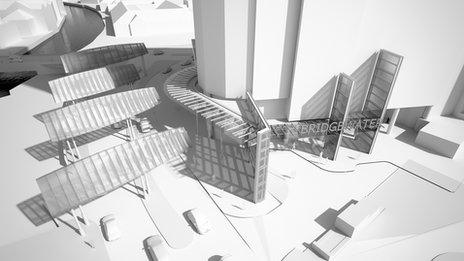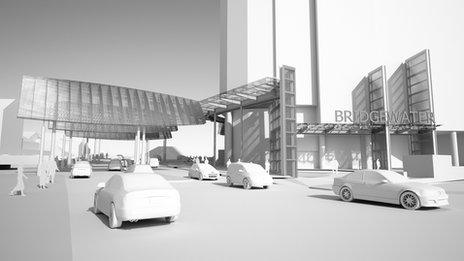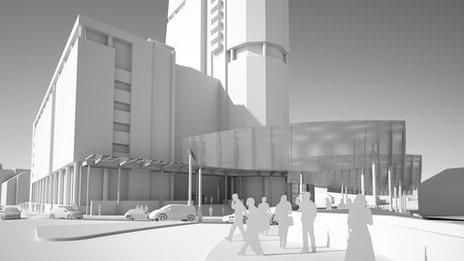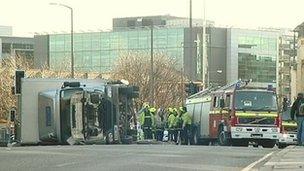Leeds' Bridgewater Place gets new high wind road ban
- Published

Bridgewater Place owner CPPI wants to put up screens and boards to deflect the wind

Initial proposals to protect the public from dangerous winds around the building were unveiled before Leeds City Council's City Plans Panel

Plans for three vertical screens and a glass canopy on the building were also revealed
Pedestrians and traffic will be barred from a road junction near Yorkshire's tallest building when wind speeds reach 45mph, a council has said.
Gusts of wind around the Bridgewater Place building in Leeds were blamed by a coroner for blowing over a lorry that crushed Dr Edward Slaney in 2011.
The building's owners want to put screens across Water Lane near the building which would deflect the winds.
The council said the measures were temporary until the screens were built.
In 2011, strong winds around the 367ft (112m) high tower blew a lorry over, killing pedestrian Dr Slaney.
The proposals would see large screens and baffle boards to deflect the wind - up to 50ft (17m) high and 66ft (20m) long - built near the building and above the road.
Coroner Melanie Williamson said the junction should be closed to all users when gusts reached about 45mph.
The authority's previous policy was to close the roads to vehicles, including bicycles, when wind speeds reached 65mph.
Now Leeds City Council said it had "reviewed its wind policy covering the Bridgewater Place junction to include further safety precautions in the light of a coroner's recommendations".

The lorry toppled over during strong winds next to Bridgewater Place and hit Edward Slaney
The city council said changes in its policy included lowering the wind speed needed to trigger the closure of the junction to 45 mph, in accordance with the coroner's suggestion, closing some pedestrian crossing points, putting the extended pedestrian shelter in place and providing alternative routes, along with extra warning signs.
Councillor Richard Lewis, who is responsible for development and the economy in Leeds, said: "We are putting in place sensible solutions in line with the coroner's recommendations as a temporary measure to make the Bridgewater Place junction as safe as possible until the permanent design solution is in place."
Dr Slaney, 35, from Sowerby Bridge, West Yorkshire, was walking on a bridge over the River Aire in Neville Street when the lorry toppled over on to him on 10 March 2011.
The inquest into his death heard the area around the tower had become known for strong winds since it was completed in 2007.
- Published16 January 2014
- Published8 January 2014
- Published6 December 2013
- Published3 December 2013
- Published23 April 2013
- Published9 February 2012